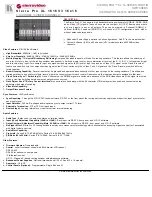
Verifying the installation requirements
To set up the SN4000B SAN Extension switch for
the first time, you will need the following:
•
Workstation with an installed terminal emulator
(such as HyperTerminal)
•
Unused IP address and corresponding subnet
mask and gateway address
•
Serial cable (supplied with the switch)
•
Ethernet cable
•
Access to an FTP server, SCP server, or USB
device for backing up the switch configuration
(optional)
•
SFP transceivers and cables
Planning the site environment
To ensure adequate cooling, install the switch with
the non-port side (which contains the air intake
vents) facing the cool-air aisle. Verify that the
ambient air temperature does not exceed 40°C
(104°F) and that the ambient humidity remains
between 20% and 85% while the switch is
operating.
To install and operate the switch successfully,
ensure that:
•
The primary AC input is 100–240 VAC, 50–60
Hz. The switch autosenses the input voltage.
•
The primary outlet is wired correctly, protected
by a circuit breaker, and grounded in
accordance with local electrical codes.
•
The supply circuit, line fusing, and wire size
are adequate, as specified by the electrical
rating on the switch nameplate.
For additional power supply information, see the
B-series 16Gb FC Switches Hardware Reference
Guide available on the Hewlett Packard Enterprise
website: http://www.hpe.com/support/sn4000b/
manuals.
Installing the switch in a rack using the
Rack Mount Kit
For optimal cable management, Hewlett Packard
Enterprise recommends that you install the SAN
Switch Rack Mount Kit to allow the nonport side of
the device to slide out of the cool-air side of the
rack. In this installation, the port side of the device
is set back from the edge of the rack, allowing a
more gradual bend in the fiber optic cables.
The following items are required to install the device
in a rack:
•
Power cables
•
#2 Phillips screwdriver
•
SAN Switch Rack Mount Kit hardware
Table 1 (page 2) identifies the rails and
rail-mounting hardware.
Table 1 SAN Switch Rack Mount Kit hardware
Description
Item
Two rear mounting brackets
A right inner rail and a right outer
rail
A left inner rail and a left outer rail
Sixteen #8-32 x 5/16-inch Phillips
flathead SEMS screws
Twelve #10-32 x 1/2-inch Phillips
panhead screws with captive star
lock washers
Eight #10 alignment washers
Eight #10 adapter washers
CAUTION:
For proper air flow, the SFP+
media side of the device port side must face
the rear of the rack. This allows cool air to
enter the front of the rack and exit from the
rear.
To install the device in a rack:
1.
Verify that the required parts and hardware are
available (see Table 1 (page 2)).
2.
Choose a mounting location for the device in
the rack.

























